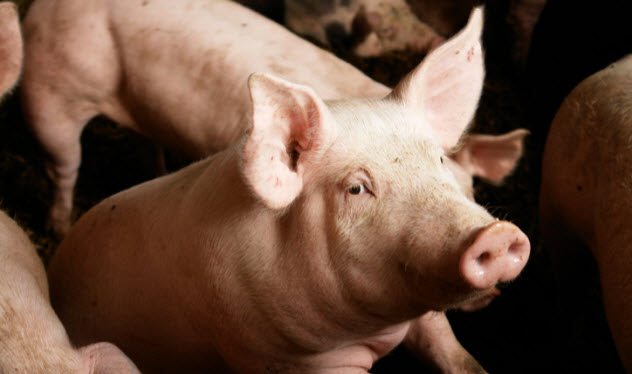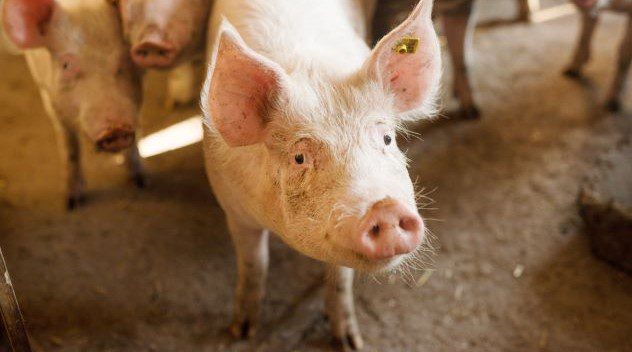[ad_1]
Pigs are curious creatures. You might think the best they can do is spend their lives playing about in the mud before being made into bacon. But our porcine pals play a key role in scientific development, helping researchers from a range of fields to expand their understanding. In some cases, these experiments are fascinating but innocent, like teaching an AI to work out if a pig is stressed. But others are more contentious than that, especially the studies that involve organ transplants, gene editing, and cloning.
These little grunters have opened up avenues of knowledge far and wide, from coconut water insemination to cross-species heart transplants. These are some of the most fascinating—and in some cases, the most ethically debatable—uses for pigs in modern science.
Related: 10 Social And Biological Experiments With Freaky Results
10 Bionic Invention Helps Turn Back Erectile Dysfunction

It happens to the best of us. We all grow older, wear and tear sets in, and before you know it, you’re at that point where things don’t quite work like they used to. Even pigs have difficulty getting it up sometimes.
But now there’s a bionic patch to solve their limp woes. In January 2023, researchers in China unveiled new technology to help boars maintain their erections. It goes by the name of artificial tunica albuginea, or ATA. The device mimics the complex tissue microstructures of the penis and can carry the weight without breaking. This allows the damaged members to become aroused again.
There’s a long way to go before similar patches can be used on humans, but the team is optimistic that their invention could help male reproduction in years to come.[1]
9 Synthetic Glue Could Treat Lactose Intolerance

Conditions like lactose intolerance, diabetes, and obesity can drastically impact people’s lives. Scientists from MIT say the solution could lie in a type of synthetic glue. The specialist adhesive sticks to the wall of the small intestine, where it regulates how nutrients are absorbed. The gut is vital for getting nutrients into the body. But Giovanni Traverso and his team noticed that it doesn’t always take in as much as it could. So they created a chemical glue inspired by the way mussels grip onto wet rocks by the sea.
But how do you get glue into the small intestine? Won’t it just stick to the other organs along the way? Well, here is where the pigs come in. The MIT team created a drink from the glue’s chemical ingredients. But they only begin to combine once they mix with an enzyme in the small intestine. This forms an adhesive substance known as polydopamine.
Tests on pigs demonstrated how the glue could increase the absorption of different nutrients. It all depended on the chemical composition. Adding lactose improved lactose digestion by as much as 20 times the regular rate. And mixing the polydopamine lining with nanoparticles meant the pigs took in less glucose. Scientists say this could have ramifications in treating diabetes and obesity. Both conditions are connected to excess glucose.[2]
8 Genetically Altered Heart Transplants: Life-Saving Innovation or Unethical Practice?
In the summer of 2022, two brain-dead patients in New York received genetically modified pig hearts. Surgeons pulled off the complex procedure, known as a xenotransplant, with no signs of rejection. Over three days of monitoring, the new hearts remained in good health, and neither body caught any diseases.
Scientists at New York University altered the pig hearts in ten ways. Six of those were to add human genes, which encouraged healthy growth and minimized the risk of rejection. The other four blocked pig DNA.
This isn’t the first breakthrough around pig heart transplants. Just months earlier, 57-year-old David Bennet received the first xenotransplant at the University of Maryland Medical Center. Bennet suffered from terminal heart disease and sadly died two months after the procedure, possibly due to infection from the new organ.
Fascinating as they are, as I’m sure you can imagine, these experimental operations are riddled with controversy. There are ethical worries that scientists could be playing God. Plus, many animal rights activists are angered by the research.
But others are keen to highlight the drastic shortage of donor organs, especially in the U.S. The transplant waiting list in the States now stands at 106,000 people. Per day, there are an average of 17 deaths of people waiting for new parts. Scientists hope that genetically altered pig transplants could go some way to reducing the crisis.[3]
7 Pigs Can Breathe Oxygen Through Their Anuses
It sounds ludicrous, but the research may one day save lives. Pigs can essentially breathe through their bumholes. The eyebrow-raising discovery came about when a team of scientists tried to come up with a medical alternative to the ventilator. When an ICU patient’s oxygen level drops, doctors use a ventilator to propel air into their lungs. But this risks causing damage to the lung tissue.
Takanori Takebe believes he has an alternative. The Japanese researcher has found a way for the body to absorb oxygen through the intestines. And his study involved flushing fluids up pig anuses.
Takebe and his colleagues set about giving their porky test subjects enemas using an oxygen-rich liquid called perfluorocarbon. They saw a marked increase in the pigs’ blood oxygen levels each time they inserted the fluid.
The group believes that doctors could use a similar technique to treat humans, especially in countries that struggle to afford ventilators. Perfluorocarbon is already used to help the lung development of premature babies, so the risk of toxic side effects is low.[4]
6 Calcite Analysis Confirms Oldest Animal Cave Painting
Here’s something a little bit different from the other entries. Not a physical pig per se, but a cave painting of one, said to be the oldest ever discovered. Archaeologists discovered the ancient artwork in a remote cave on the island of Sulawesi in Indonesia. It depicts a Sulawesi warty pig and measures 53.5 inches (136 centimeters) by 21 inches (54 centimeters).
Scientists used a Uranium-based dating technique to determine the age of the artwork. Maxime Aubert noticed a calcite deposit covering the pig, which he found was 45,500 years old. But the painting itself may well date back further. “It could be much older because the dating we’re using only dates the calcite on top of it,” Aubert explained.
Archaeologists also found two hand prints hovering over the back of the warty pig. From these, scientists hope to extract DNA samples, which could teach them more about the life of ancient humans.[5]
5 Pigs Taught to Play Video Games
In 2021, researchers published a paper in the Frontiers in Psychology journal detailing their attempts to turn pigs into gamers. Hamlet and Omelette were the names of two Yorkshire pigs, while the Panepinto micro pigs went by Ebony and Ivory. Staff at Purdue University coached the animals to operate a joystick with their snouts.
The game on the screen in front of them was a simple one, but the quartet showed surprising aptitude. Each time they used the controls to move toward a target, they got a snack. Even when the treats were taken away, the gammon gamers carried on playing. Scientists described the research as “remarkable.” Their paper suggests pigs are more intelligent and cognitively skilled than previously thought.
“It is no small feat for an animal to grasp the concept that the behavior they are performing is having an effect elsewhere,” wrote Dr. Candace Croney. “That pigs can do this to any degree should give us pause as to what else they are capable of learning and how such learning may impact them.”[6]
4 Shot in the Head to Study Blood-Splatter Patterns
The use of animals in scientific research is often controversial. This is especially true when it comes to shooting them in the head. In 2015, scientists in New Zealand made headlines over a study that involved firing bullets through pig skulls.
Many of the pigs’ heads came from the butchers, but the researchers shot five live adult pigs. The animals were sedated, strapped to a table, and killed with a pistol or a semi-automatic rifle. Three were shot from a distance of 4 feet (1.2 meters), and the other two received their bullet point blank.
As cruel as it is, the Institute of Environmental Science and Research says it provided vital insight into “gunshot-related back spatter” and could help solve gun crimes. When a bullet enters the head, blood, tissue, and bone often spurts out in the other direction—but not always. The pig-shooting study looked into why this only sometimes happens and the factors involved. With blood-splatter analysis, forensic experts can often tell the difference between murder and suicide.[7]
3 Facial Recognition Could Improve Farm Animals’ Quality of Life

A scientific experiment is exploring the emotions of farm animals. Researchers at the Pig Research Centre, part of Scotland’s Rural College (SRUC), reckon their findings could lead to an increase in porcine well-being.
In 2019, SRUC announced a new project using facial recognition to see if an animal is pleased or in distress. As part of the study, the team created 3D and 2D images of pig faces. These sow snaps are then analyzed at the University of the West of England. There, researchers are discovering new ways to tell what emotional state a pig is in based on its facial expression.
The technology is still in development, but scientists say it could be used to flag health complications or welfare issues on farms. “Machine vision technology offers the potential to realize a low-cost, non-intrusive, and practical means to biometrically identify individual animals on the farm,” explained machine vision expert Melvyn Smith.
“Our work has already demonstrated a 97% accuracy at facial recognition in pigs. Our next step will be, for the first time, to explore the potential for using machine vision to automatically recognize facial expressions that are linked with core emotion states, such as happiness or distress, in the identified pigs.”[8]
2 New Insemination Technique Involving Coconut Water

For most of us, coconut water is a sweet, exotic drink, something to quench our thirst on a hot day. But scientists in Uganda have found another, much more unlikely use for the beverage: artificial pig insemination.
Researchers at Gulu University are developing the unorthodox technique, which they hope could be rolled out to countries across Africa. Water from young coconuts is rich in nutrients like sodium and potassium. So using the fluid to deliver semen into the sow should improve the chance of fertilization. Aiding pig insemination is particularly important in a country like Uganda, where the pork demand is 7.5 pounds (3.4 kilograms) per capita per year. The team hopes their research will offer smallholder farmers an affordable, accessible way to rear better-quality animals for meat.
As lead researcher Elly Ndyomugyenyi told reporters, “High concentration of sodium and potassium in the green coconuts are factors which help in sperm motility and longevity. Coconut fruits are readily available in the local markets. They are sold like other local fruits.”[9]
1 The AI Robots That Can Clone Pigs
Artificial intelligence and cloning are two of the most hotly debated frontiers in modern science. Combine the two, and you’re opening up a hotbed of ethical uncertainty.
Nonetheless, in June 2022, scientists unveiled the first set of piglets to be cloned by robots without any human intervention. The group work at the University of Nankai in Tianjin, China. They claim their research shows that removing humans from the cloning process reduces the margin for error. The AI-powered machines are said to be more successful at cloning pigs than humans are.
“Each step of the cloning process was automated, and no human operation was involved,” researcher Liu Yaowei told reporters. “Our AI-powered system can calculate the strain within a cell and direct the robot to use minimal force to complete the cloning process, which reduces the cell damage caused by human hands.”[10]
[ad_2]
Source link

